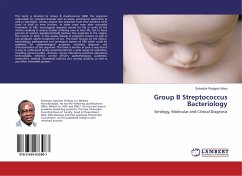
Group B Streptococcus Bacteriology
Serology, Molecular and Clinical Diagnosis
Versandkostenfrei!
Versandfertig in 6-10 Tagen
22,99 €
inkl. MwSt.

PAYBACK Punkte
11 °P sammeln!
This book is devoted to Group B streptococcus (GBS) the organism responsible for neonatal diseases such as sepsis, pneumonia septicemia as well as meningitis. Infants acquire this organism from their mothers' birth canal at birth or even in-utero. In some cases even after successful treatment of GBS, neurological sequelae persist for life in some of the infants resulting in serious human suffering even in later life. Ten to forty percent of women asymptomatically harbour this organism in the vagina, the rectum or both. It also causes disease in pregnant women as well as non-pregnant adults irr...
This book is devoted to Group B streptococcus (GBS) the organism responsible for neonatal diseases such as sepsis, pneumonia septicemia as well as meningitis. Infants acquire this organism from their mothers' birth canal at birth or even in-utero. In some cases even after successful treatment of GBS, neurological sequelae persist for life in some of the infants resulting in serious human suffering even in later life. Ten to forty percent of women asymptomatically harbour this organism in the vagina, the rectum or both. It also causes disease in pregnant women as well as non-pregnant adults irrespective of sex. This book focuses on the history, bacteriology, pathogenesis and serological aspects of GBS which could be exploited for epidemiological purposes, including diagnosis and characterisation of the organism. This book is written in such a way that it is easy to understand hence recommended for a wide range of readership, including general public, clinicians, nurses, laboratoryscientists, laboratory technologists, infection control officers, epidemiologists, academics, researchers, medical, biomedical sciences and nursing students as well as any other interested persons.












